For many years, the Swiss Super League has been the domain of dominance for FC Basel.
However, the giant started to struggle in 2017, which was the chance for new champions in the Alps.
BSC Young Boys, a club that has been runner-up multiple times during the years of Basel’s championships, stepped up to the task, winning six out of the seven league titles in Switzerland.
With prominent coaches like Adi Hütter and Gerardo Seoane, BSC Young Boys (YB) took over the league by storm, becoming the new dominant force.
After only finishing third in the 21/22 season, YB opted to appoint Raphael Wicky as the new Head Coach to regain control over the league.
While things looked good during their first season (Young Boys crowned themselves champions with a 16-point lead over Servette), things became tighter during the 22/23 season, and they decided to move on from Wicky.
After Magnin took over as an interim coach and won the league again, they still opted to sign a new coach in the summer.
Obviously, the job opening was the most appealing in the Super League since the job became available the last time so that YB could choose from a big pool of potential candidates.
Their coach of choice was Patrick Rahmen, a very experienced coach who previously worked for Hamburger SV, FC Aarau, FC Basel, and last season for FC Winterthur, where he was able to achieve a surprising sixth-place finish, coaching the third-best offence in the league.
Still, Young Boys’ start to the season was a huge disappointment, losing their first two games to freshly promoted FC Sion and last year’s third-place team in Servette.
With the expectation of becoming champions once again, that is a rough piece of work to start on for Patrick Rahmen.
In this tactical analysis and scout report, we will provide an in-depth analysis on what part of Patrick Rahmen tactics he brought from the small FC Winterthur to the prominent Young Boys and how he implemented his playing style in the first two games of the season.
Patrick Rahmen Formations And Players Used
Patrick Rahmen brought his style of play to Bern, but he also respected the style of play that the club has implemented over the last couple of years.
In both games, YB have used a 4-4-2 formation to start the game, a rather traditional way of playing.
Captain von Ballmoos starts in goal after winning the battle against Rahmen’s last goalkeeper, Marvin Keller, a Swiss U21 national team player.
The back four underwent changes on the left side after Hadjam was sent off in the first game against Sion, with Persson and Zoukrou rotating into the starting eleven against Servette for Hadjam and Husic.
The right side of the defensive line consists of Sandro Lauper and Lewin Blum.
Filip Ugrinic is the key player in midfield.
Currently, he is partnered with young holding midfielder Miguel Chaiwa.
Out wide, Joel Monteiro started both games, with Kastriot Imeri and Mershack Elia playing on the other wing.
Up front, Silvère Ganvoula has earned his starting spot at the moment, starting both games.
Against Sion, Rahmen opted to use the quick and shifty Elia as a partner for the big target man Ganvoula, but against Servette, Rahmen even used a second target man in Cedric Itten to pair up with Ganvoula.
While the double pivot and the right side of the formation seem set, YB used a hefty rotation on their left side in just two games of the season, showing that Rahmen has not found his perfect eleven just yet.
Wing-Play And Diamonds
Patrick Rahmen was surprisingly successful with his small club side at FC Winterthur.
The offence, especially their efficient attack of the wings, was vital to this success.
In the first two games, YB are also showing many of the traits that Winterthur showed last season.
Rahmen’s men are focusing on attacking through the wings, especially on their right side.
In the build-up, the centre-backs are tasked with relatively easy passes between themselves until they trigger to play through a pass onto one of the full-backs.
Most of the time, Rahmen’s men trigger play through a pass from Lauper to Blum.
The full-backs are tasked with receiving the ball in at least a half-open stance and turning towards the field with their first contact.
The moment the ball reaches the full-back, Young Boys start to build triangles on that side of the pitch.
More specifically, they are building a diamond on the wing consisting of the full-back, the near-sided central midfielder, the winger, and the near-sided striker.
Rahmen implemented this at Winterthur last season as well but in a slightly different way.
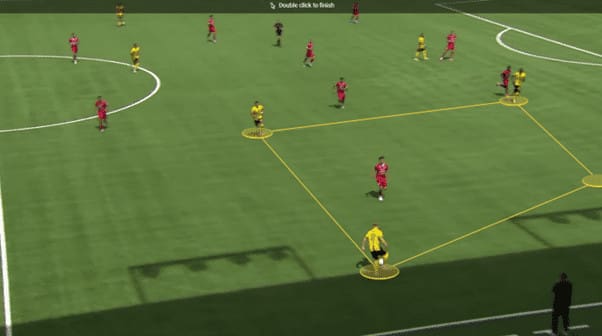
After receiving the ball, Blum has multiple options.
In this example, he plays a first-time pass to Ganvoula, who is dropping into midfield and dragging his defender out of position.
Ganvoula now has multiple options as well and decides to play a lay-off to Monteiro.
Blum doesn’t just stand around; he instantly realizes the newly created space and makes a good run in behind the defence, where Monteiro can find him.
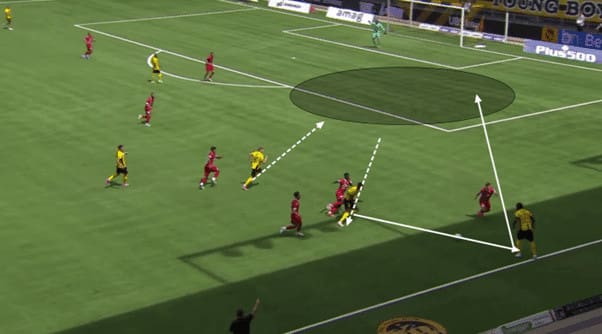
From there on, Blum has an easy job of crossing the ball into the box, where he finds Elia, who misses the best chance YB created in the game against Sion.
Overload To Switch
Overall, Rahmen’s positional play is really interesting because he doesn’t really use the centre of the field to attack.
His wing play gives his players multiple options through forming diamonds and even allows them to keep possession or set up for the switch.
It is a way of using principle overload to isolate, and YB use that to their advantage as well.
The far-sided winger often pushes inwards, playing as more of a half-space attacking midfielder.
This opens up the possibility of a run for the far-sided full-back.
Against Servette, Young Boys showed their ability in this area multiple times.
Again, the centre-back is tasked with easy passes towards the full-back, providing width in this situation, where the winger is pushing inwards.
Rahmen’s side is forming a diamond, keeping the ball in possession for a long period of time and keeping the defence moving.
The defenders need to react and push towards the left side of YB as well.
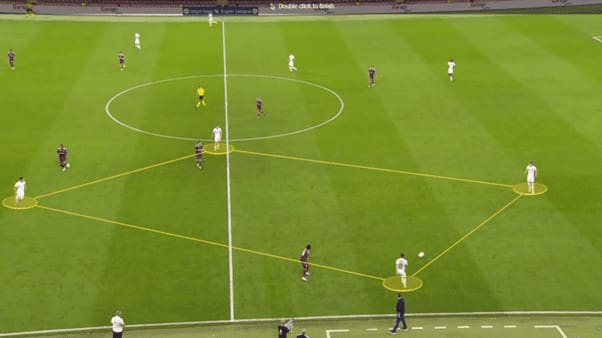
This opens up the opportunity for Lewin Blum.
He moves forward using his pace, running behind the defensive line.
The defenders are not able to react to the run or get enough pressure on the ball to prevent the switch from being played.
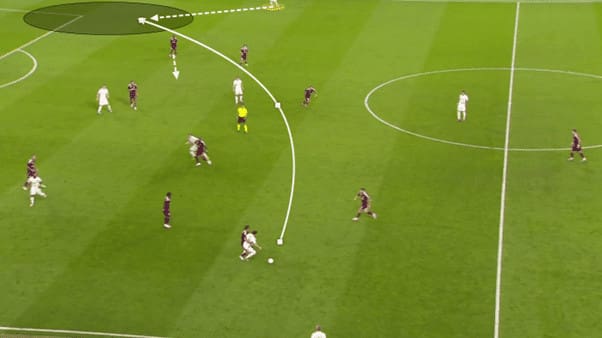
Blum then squares the ball for Itten, who finishes the opportunity and scores a goal clinically.
This is another way of utilising their diamonds and wing play that Rahmen implemented during the preseason.
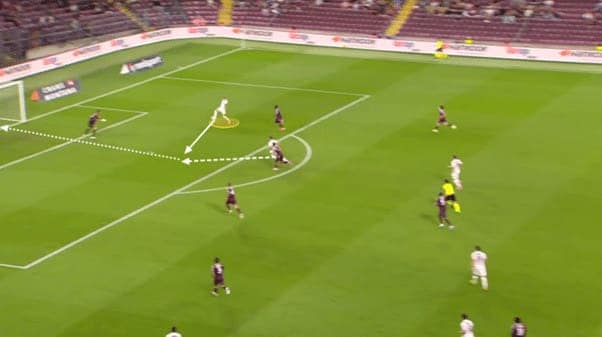
However, this also means that YB are very reliant on crossing to create scoring chances.
Pretty much all of their opportunities came from crossing, especially in their game against Sion, where they had 37 crosses, an insanely high mark.
Another big problem right now is the imbalance between the right and the left side.
While Lewin Blum and Sandro Lauper on the right side are consistently creating opportunities and progressing the ball towards goal, the left side is struggling big time to start the season.
Against Servette, not a single attack resulting in a goalscoring chance was launched on the left side for YB; they will definitely need to work on that to not be predictable for the opposing defences.
BSC Young Boys Key Player – Lewin Blum
After reading these last two paragraphs about how Patrick Rahmen and Young Boys played during their first two matches, I noticed that one name was used way more often than the rest of the team: Lewin Blum.
The soon-to-be-23-year-old right-back from Switzerland made his breakthrough into the first team two years ago.
He has featured in nearly 100 matches since then and made 11 appearances for the under-21 national team.
In a time when big teams like Manchester City and Pep Guardiola are moving away from traditional full-backs and are converting pacey centre-backs like Josko Gvardiol into full-backs, Blum emerges as a very talented conventional right-back.
Blum’s strengths lie out wide, where he plays quick passes and moves forward well.
His crossing ability is also very good.
Last season, he provided eight assists in 39 games, a very decent mark.
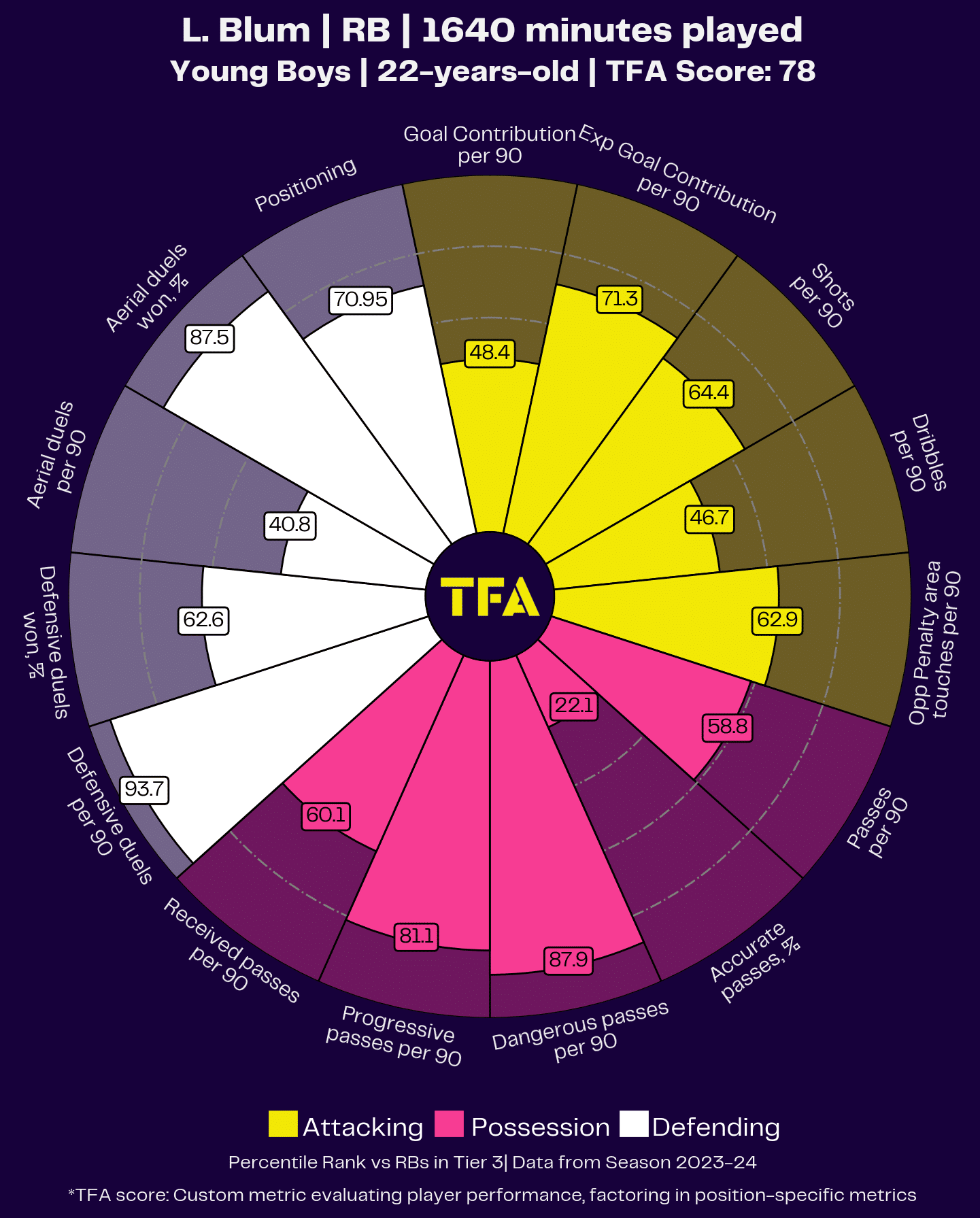
In Rahmens’s system, Blum is being tasked with a vital role in the build-up as well as in attacking play.
Blum is receiving a lot of balls from the centre-backs and is tasked with finding quick solutions to progress the ball.
His ability to play progressive passes as well as dangerous passes is elite for a right-back at his level, ranking above the 80th percentile each.
In both games so far, Blum was the player that created the most scoring chances and xA for YB, remarkable for a young right-back.
Blum is also a great player defensively.
He is able to adapt to every situation and has defensive action all across the pitch, whether it is pressing or a deep block.
He ranks in the 94th percentile in defensive actions per game over the last season and has shown his strength against the ball to start this season as well.
Lewin Blum has been outstanding so far and definitely has made the next step in terms of development.
This isn’t a scouting report for him, so we will move on now, but don’t be surprised when you hear his name in a big league sooner rather than later.
Considerable Distances And Not Being Compact Enough
If we look back at Rahmen’s time at FC Winterthur for a brief moment again, a couple of negative things stand out, even though their season was rather impressive.
One of those things is Winterthur’s defensive performance last season.
While their attacking play was potent enough to get them into the top half of the table, Winterthur also conceded 71 goals in 38 games, with only relegated Stade-Lausanne conceding more goals.
Now, through two games this season, Young Boys have conceded five goals, a bad mark for a top team.
It is rather interesting that they used two very different sets of tactics in those two games.
Against Sion, Rahmen was rather conservative with his defensive approach.
While YB occasionally pressed in the attacking third, they fell back into a deep block most of the time.
The 4-4-2 is a formation that has been used to defend in a deep block by many teams for a long time simply because it covers a lot of width and depth, and the distances between the players are rather short.
YB has been a very counterpressing-reliant team ever since Adi Hütter brought the Red Bull DNA to Switzerland with YB.
Against Sion, however, Rahmens’ men were not on the same page about counterpressing.
They allowed 11.37 passes per defensive action (PPDA), a very bad mark compared to last season’s marks.
Of course, it was also rough for them being down one man after Hadjam was sent off, but both goals YB conceded followed the same pattern of problems: Half the team went into counterpressing and tried to win the ball back quickly, while the other half was falling back.
Both goals resulted out of a long pass that the centre-backs were not able to clear away, leaving Sion with good opportunities.
Overall, the Sion game is special, not just because of the 10vs11 situation but also because the first goal resulted from a crucial mistake by keeper von Ballmoss, which is why we are going to look at the Servette game in more detail now.
Against Servette, Rahmen and his team were much more aggressive in their defensive approach, consistently trying to put pressure on Servette’s build-up play.
YB pressed aggressively in the attacking third and managed to allow only 5.4 PPDA, a great increase compared to the game against Sion.
What’s really interesting about the way they defended against Servette is that they used a hybrid press.
While the attackers and wingers attacked the ball in zone coverage, a very traditional way of pressing out of a 4-4-2 formation, both central midfielders were man-oriented and assigned towards Servette’s double pivot.
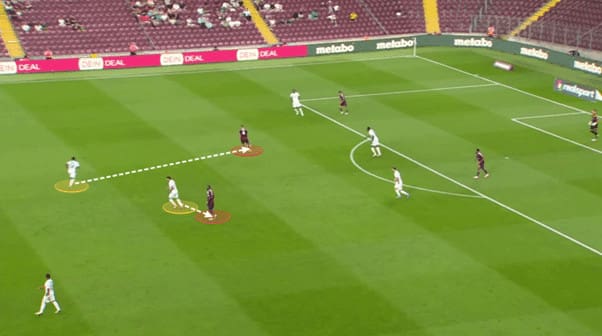
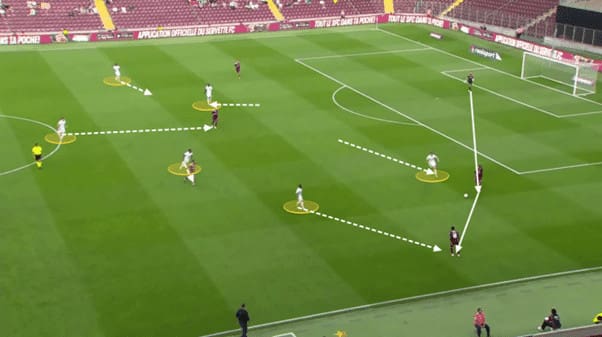
In these examples, six YB players are pushing forward to press the build-up of Servette.
While Itten and Ganvoula are attacking the centre-backs, the near-sided winger is pressing the opposing full-back, and the far-sided winger is moving inside to be nearer to the ball.
Both midfielders are marking Servette’s midfielders, preventing them from receiving the ball.
While they were able to generate some pressure on the build-up of Servette, this style of pressing also has its downsides.
Moving this far forward with your entire midfield leaves acres of space open between the line.
Servette used long balls to bridge over the press and to progress the ball.
This forced the Young Boys’ defensive line to step up and then lacked compactness, and because of the high position of the midfielders, it was hard for YB to recover loose balls in these zones.
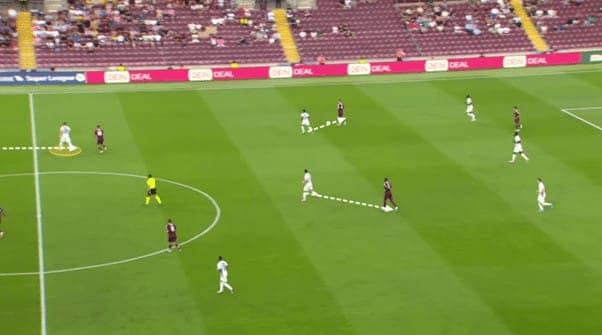
In this example, Lauper needs to step up with the Servette striker to prevent him from being able to turn towards goal.
There is no chance for any Young Boys attackers to recover into the situation.
Lauper moving out of his CB position is very dangerous because now there is space for runs in behind the defence.
The YB defenders are also not very comfortable in this situation, scrambling around trying to pick up the pieces of the defensive stability left.
Attacking these zones proved very effective for Servette, as they scored two goals this way.
Patrick Rahmen will quickly need to find a way to improve the rest of Young Boys’ defence, or he will face the same defensive struggles his Winterthur side has faced.
Outlook On Matchday 3 Versus St. Gallen
So the start to the season has been rather rough for Patrick Rahmen as the new head coach for YB.
Unfortunately for him, these next couple of weeks are going to fly by for his team and him quickly.
Between league games, there also will be multiple UEFA Champions League qualifying matches as well as games in the Swiss Cup.
On Saturday, Young Boys will face off against FC St. Gallen, another team with a coaching swap this offseason.
FCSG lost their coach, Peter Zeidler, to VFL Bochum in the Bundesliga and replaced him with a former Bundesliga coach in, Enrico Maaßen.
St. Gallen has been playing with a 4-diamond-2 in the last couple of seasons, and this is their first game under their new coach.
For Rahmens’ men, this will be a chance to attack St. Gallen’s left-alone full-backs with their wing-focused attacking play and create a ton of crossing opportunities again.
However, a midfield diamond usually means domination for the team it uses.
The way Young Boys have been pressing against Servette won’t work against FCSG simply because Ugrinic and Chaiwa will be outnumbered in midfield by the opposing players.
Rahmen will need to make minor changes to the press and move his wingers inwards a bit to not lose control over the midfield.
In terms of personnel usage, Rahmen would be wise not to rotate too much again.
Von Ballmoss will stay in goal, Laiper and Zoukrou should stay as the pairing in the centre of the defence, Blum obviously will start again, and Hadjam should come back into the starting line-up after being suspended again.
In midfield, Rahmen will probably make a minor change and move to a 4-2-3-1 formation.
Late in the game against Servette, he also made this exact change, and it proved very effective.
They can still move into their 4-4-2 against the ball quickly, but with an additional midfielder, it is easier for Rahmens’s men to construct the diamonds and triangles they need to create chances and have more control in the centre of the pitch.
Darian Males or Kastriot Imeri would be the first candidates that come to mind as an attacking midfielder that Rahmen can throw in.
Up front, either Itten or Ganvoula will start again.
Conclusion
In the end, it was only two games.
The start of the season proves crucial for many teams, but especially for a team with big expectations like YB, a quick turnaround is needed.
Patrick Rahmen already coached a big club in Switzerland with FC Basel and struggled immensely in his time there.
With Young Boys’ history of firing coaches, Rahmen would be wise to quickly get his team back on track.
While Rahmen managed to implement a lot of the positive things that he did with Winterthur and even managed to adapt to his new players and get the best out of them in that phase, he also brought over the defensive struggles his Winterthur side faced as well last season.
To be a top team in the league, conceding fewer goals will be necessary for Young Boys moving forward.
Rahmen needs to find a definite way of defending and helping out his players.
Right now, many players are set up to fail in the situations they are facing defensively.
A bright spot for YB during these last two games has been Lewin Blum.
The young right-back has taken the next step in his development and proven to be a key player his coach will count on for the upcoming season.
Now, what will the future hold for Patrick Rahmen and his team?
It’s tough to say after two games, but with how close the Super League has been outside of Young Boys in these last couple of seasons, they do not want to get caught up in the mix and get their quality onto the pitch from now on.






Comments